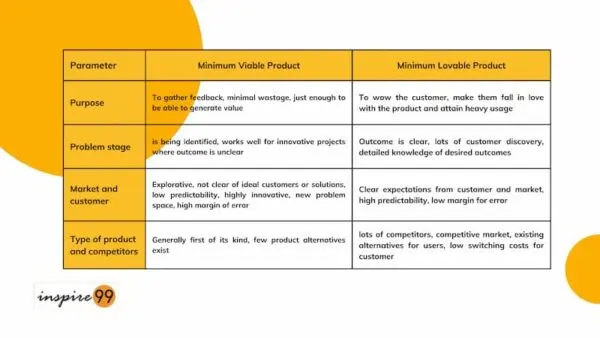In this article, we talk about the differences between Minimum Viable Product Vs Minimum Lovable Product. I love this idea of creating a product that people fall in love with – this is in short the definition of an MLP. This Minimum lovable product focuses on creating a product that’s easy to use, addictive and provides great value at every instance. The value part is basic because that’s just product development. But making sure that people fall in love while using the product and keep coming back is the principle of MLP.
While discussing an MLP, particularly as a startup, we need to ask – can we afford to do an MLP at all? Or should we just create a minimum viable product. This MVP can later be used as proof of value, market validation which can later be used to raise funds for full product development. Both approaches are valuable, the question to ask is – what suits your business the best?
What is a Minimum Lovable Product, MLP?
The definition is simple really – it is a product that people fall in love with. This love is not just in using the product, but talking about it, referring to their friends and family and being invested in the success of the product. So, you can see that the use case goes beyond just using the product to being in love with it.

The key principles in an MLP are:
- Value to the user – they should be able to do what they want to
- Ease of use – Should be simple to use, easy to onboard
- Gives a reason to come back – makes you want to spend time on the product
- Users are happy using it and want to spend time on it
Characteristics of a Minimum Lovable product
An MLP is much more than a functional product. The principles of a startup tell us to do a product that can be used. Whether it is a startup or a large business, the users of a product want to reach their outcome. Based on this, we develop a product. But what does it take for a user to fall in love and go beyond this stage of a functional product?
The typical characteristics of an MLP are:
- Simplicity: It should have only essential features, avoiding complexity.
- User-Centric: Designed with a deep understanding of user needs.
- Value: Provides meaningful value or solves a real problem for users.
- Quality: Must work reliably and be free from major issues.
- Engaging: Should capture users’ interest and engagement.
- Iterative: Allows for future enhancements and improvements.
- Delightful: Offers a positive and memorable user experience.
- Usability: Intuitive and easy to use, minimizing friction.
- Feedback-Driven: Encourages user feedback for continuous improvement
These qualities of a minimum liable product are necessary conditions but never adequate. As you see, falling in love takes a lot more than user friendly, nice and fun product to use. And that’s always a constant act of finding out what users will keep loving.
Minimum Viable Product – MVP
An MVP is different – its purpose is to test customer value. We use an MVP to experiment and get customer feedback. It helps us understand whether a customer will like the idea and their willingness to pay for a service/product. It is supposed to be a scrappy, low investment version which does just the basic things to define and create user value. Creating an MVP shows deep understanding of the customer with a desire to understand their behaviour more.
Characteristics of MVP
The qualities of an MVP are:
- Minimal Features: We focus on simple, essential features to solve the customer’s problems.
- Quick Development: We focus on the least possible investment to create something that the customer can use and provide feedback. We make sure to keep the scope as minimal as possible to help develop with minimal investment.
- Focus on Core Value: The MVP solves the main problem, the most valuable output for a customer.
- Testing Hypotheses: We design MVP to get customer feedback. The main questions to ask are: Does this solve the customer’s problem, what else is missing and most importantly – will they want to pay for something like this
- Iterative Development: MVPs are the pure embodiment of continuous customer feedback. We develop, take feedback and redevelop as a continuous cycle.
The process is lean with the main focus on minimal investment to produce a product that we can use to get customer feedback. As you can see, there’s little opportunity to create a lovable product through this process.
Difference between Minimum Lovable Product and Minimum Viable Product

Now that we know the meaning of MLP and MVP – it’s important to differentiate between the two. This image represents key differences between MLP and MVP. The biggest differences are in the purpose and stage of product development. Generally we use MVP during early stages of product development. As a startup, MVP can be most beneficial when you’re trying to enter a new market segment. Ideally in such a segment, very few direct competitors exist.
However, when you build a minimum lovable product, your purpose is to attract a customer base from an existing competitor. This means that you’re targeting people who are dissatisfied with a few aspects of the competition and don’t have a huge switching cost. This is done by establishing clear differences with the existing competitors.
MLP Vs MVP
This is a tabulated version of the differences between a minimum viable product and a minimum lovable product. Note, that they both work very well depending on the type of project. The most important thing to remember it to pick and choose the right strategy for your startup.
| Parameter | Minimum Viable Product | Minimum Lovable Product |
| Purpose | To gather feedback, minimal wastage, just enough to be able to generate value | To wow the customer, make them fall in love with the product and attain heavy usage |
| Problem stage | is being identified, works well for innovative projects where outcome is unclear | Outcome is clear, lots of customer discovery, detailed knowledge of desired outcomes |
| Market and customer | Explorative, not clear of ideal customers or solutions, low predictability, highly innovative, new problem space, high margin of error | Clear expectations from customer and market, high predictability, low margin for error |
| Type of product and competitors | Generally first of its kind, few product alternatives exist | lots of competitors, competitive market, existing alternatives for users, low switching costs for customer |

Pingback: 3 Key Traits of a Tech Entrepreneur for Success - Inspire99
Pingback: How to Become a Startup Entrepreneur? - Inspire99
Pingback: Cost of Bad Design in a startup product - Inspire99
Pingback: 5 Must consider areas for user experience in startup - Inspire99
Pingback: 25 UX quotes for an entrepreneur to build user experience - Inspire99
Pingback: People ignore design that ignores people- User Experience - Inspire99
Minimum Lovable Product – That’s a great way of emphasising the importance of Customer feedback in the product development process!
Those companies which are in competitive industries, it doesn’t make sense just to build an MVP. Such kind of products might be dime a dozen. But, building a lovable product that delights customers by introducing newer and better functionalities, might be a longer lasting strategy.